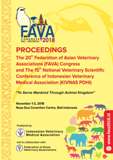MP-16 Characterization of Avibacterium paragallinarum Caused Infectious coryza/Snot: Satellite Colony Phenomenon
Abstract
Infectious coryza (IC) is an acute upper respiratory disease of poultry that can appear in all ages. Some of clinical signs that are commonly seen in IC are rhinitis, facial swelling or edema, lacrimation, anorexia, and retarded growth in young poultry [1.2.3]. The disease can be found worldwide, especially in tropical countries [4]. Infectious coryza is very important in the chicken farm industry in developed and developing countries, including Indonesia [5]. The large economic losses due to IC such as increased number of culling, decreased egg production (10-40%), decreased body weight, stunting growth, and some mortality (2-10%) [4].
Avibacterium paragallinarum which was previously classified as Haemophilus paragallinarum is a causative agent of infectious coryza in laying and broiler chickens, quail, pearl chicken, turkey, and peacocks [4,6,7,8]. The bacteria is commensal in the mucous membrane of the upper respiratory system, is sensitive to preservation and does not last long outside the host body [8]. Factors X and V are needed for the growth of several types of A. paragallinarum. According to in vitro growth requirements, A. paragallinarum can be either nicotinamide adenine dinucleotide (NAD) independent or NAD-dependent. The reduced form of NAD (NADH; 1.56-25 µg/ml) and the oxidized form (20-100 µg/ml) is required for in vitro growth in most isolates A. paragallinarum that show satellitic colony on a medium [9]. The description of the need for V factor of field isolates A. paragalinarum has been few reported. The aim of this research is to find out the phenomenon of satellite colonies from a variety of poultry isolates.

